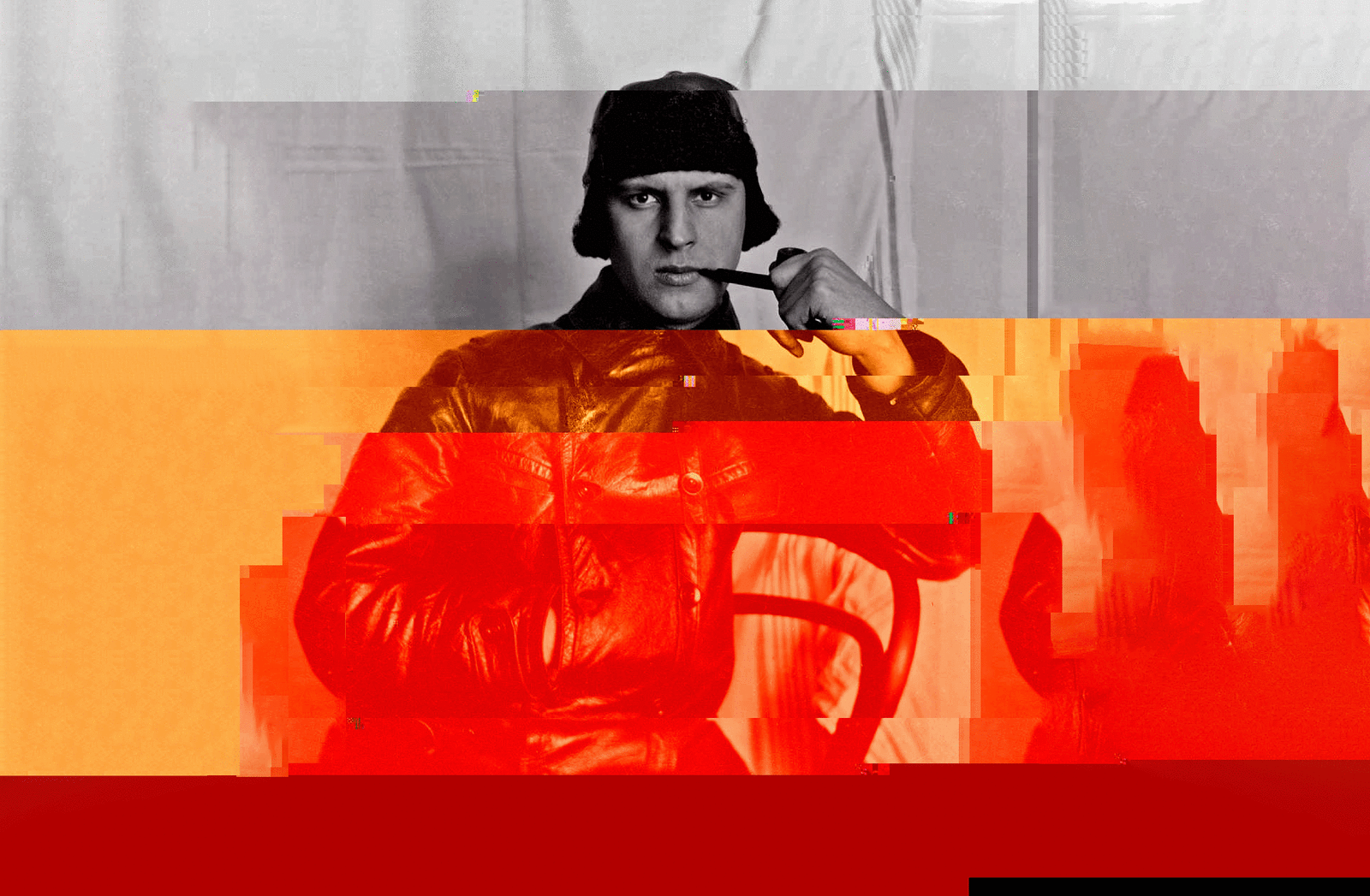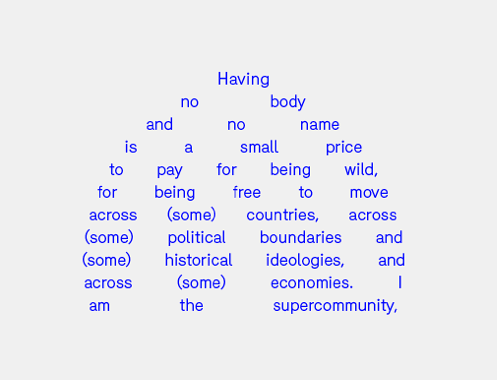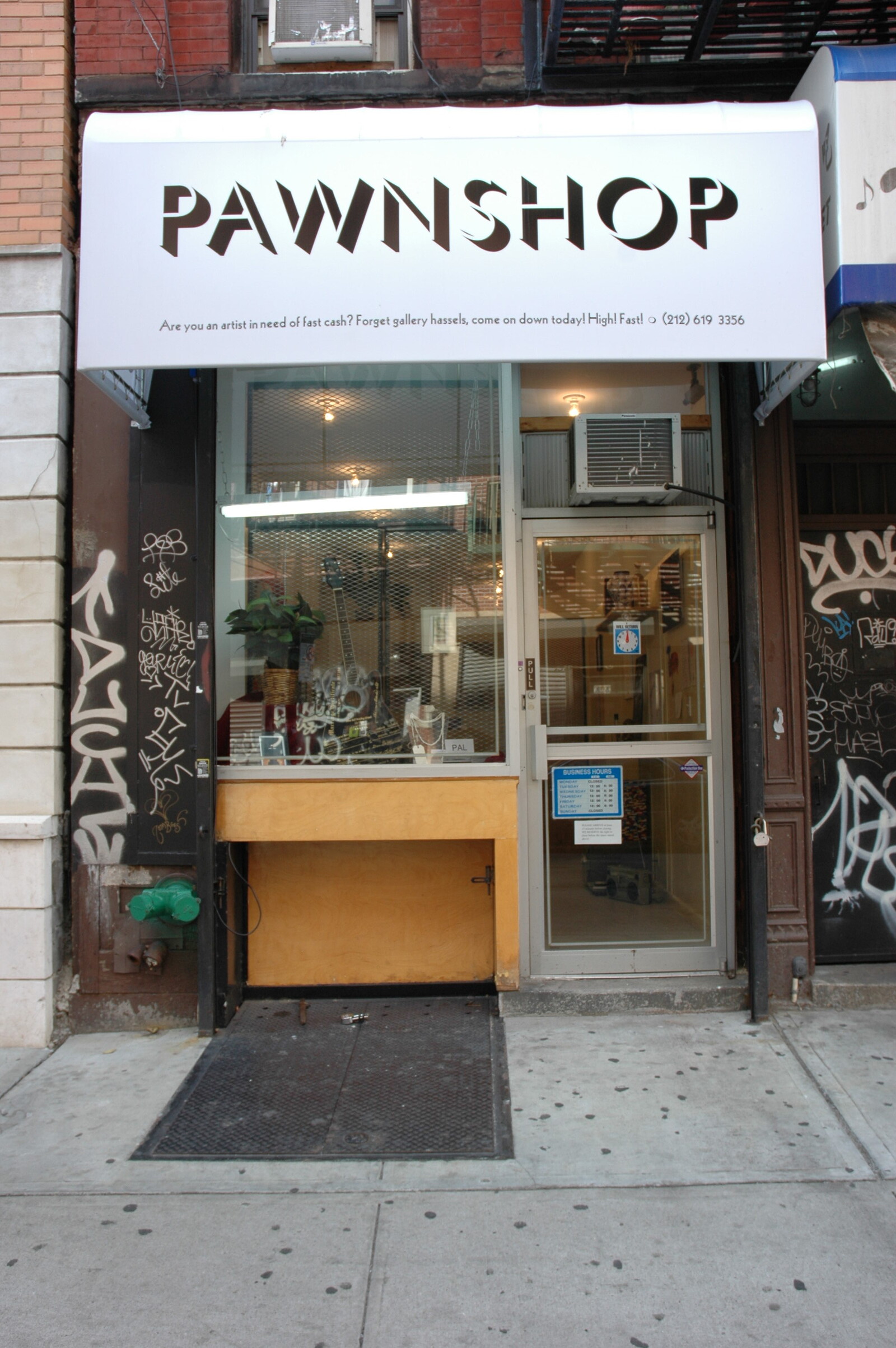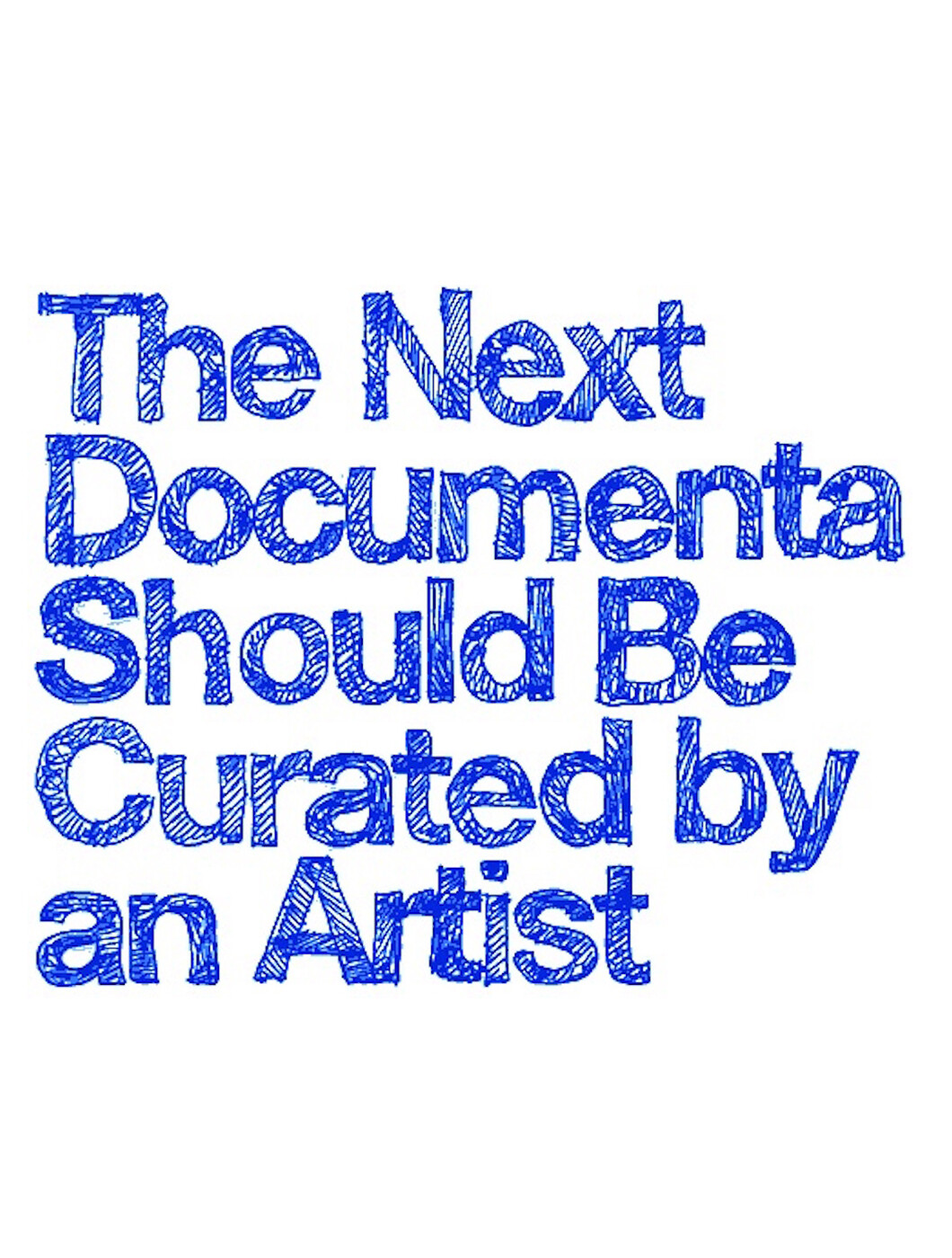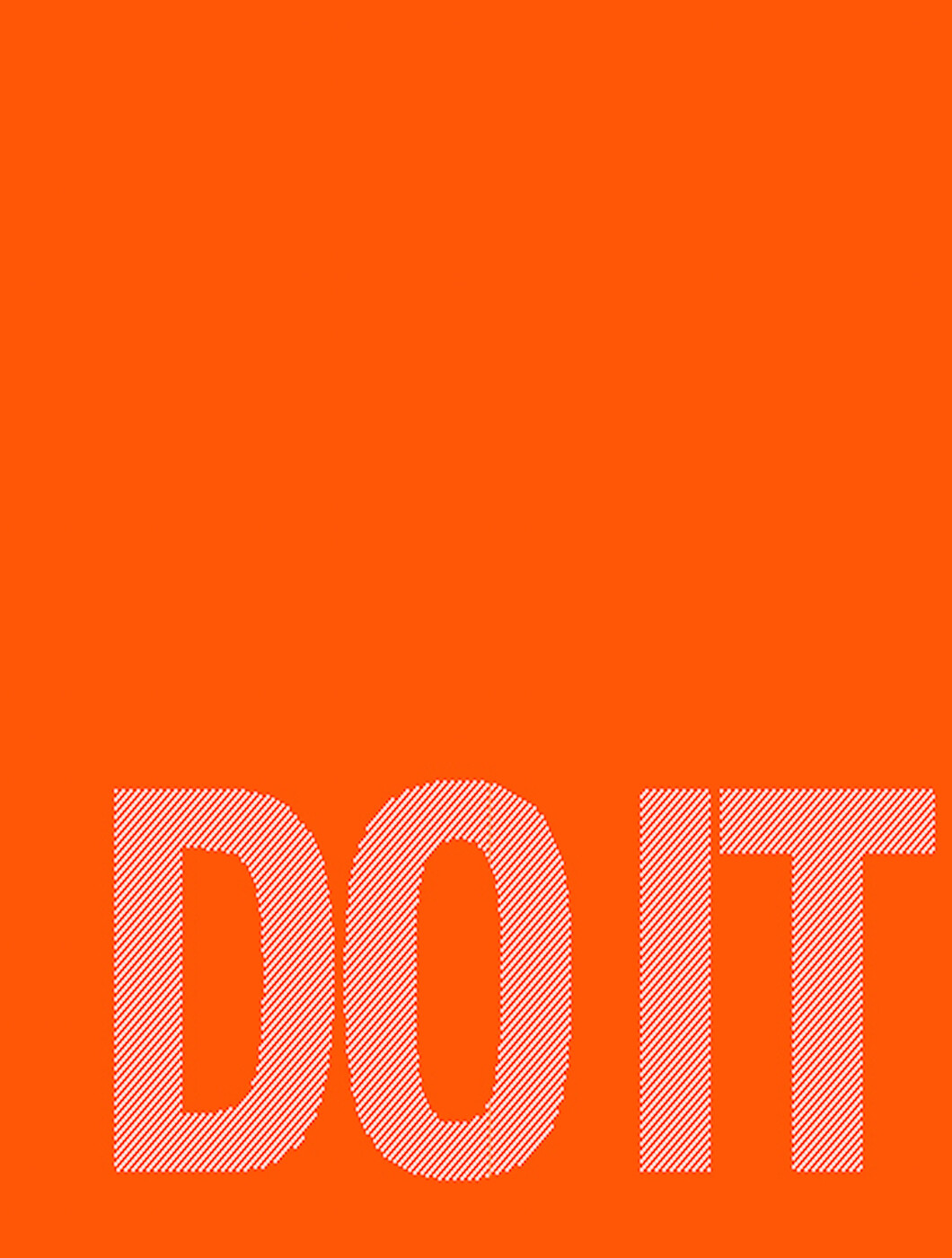Time/Bank
Time/Bank was a platform where groups and individuals could pool and trade time and skills, bypassing money as a measure of value. Time/Bank was based on the premise that everyone in the field of culture has something to contribute and that it is possible to develop and sustain an alternative economy by connecting existing needs with unacknowledged resources.
The origins of time-based currency can be traced both to the American anarchist Josiah Warren, who ran the Cincinnati Time Store from 1827 until 1830, and to the British industrialist and philanthropist Robert Owen, who founded the utopian “New Harmony” community which banned money. The first successful contemporary time bank was started in 1991 by Paul Glover in Ithaca, New York. Following his idea, people began to exchange time, which led to the creation of a time-based currency the “Ithaca Hours,” which even local businesses began to accept, and which still flourishes. Time banking and service exchange have since developed into a full-fledged movement, usually centered around local communities.
Time/Bank at e-flux was modeled on existing time banks. Every Time/Bank transaction allowed individuals to request, offer, and pay for services in “Hour Notes.” When a task was performed, the credit hours earned could be saved and used at a later date, given to another person, or contributed towards developing larger communal projects. For example, if you happened to be in Beijing or Hamburg and needed someone to help you shop for materials or translate a press release, you were able to draw on resources from Time/Bank without exchanging any money.
Through Time/Bank, e-flux endeavored to create an immaterial currency and a parallel micro-economy for the cultural community, one that is not geographically bound and that will create a sense of worth for many of the exchanges that already take place within the art field, particularly those that do not produce commodities and often escape the structures that validate only certain forms of exchange as significant or profitable.

Time/Bank at Frieze Art Fair, London, UK, 2009

Time/Store at e-flux, New York, NY, 2010

Time/Store at e-flux, New York, NY, 2010

Carolina Caycedo, currency prototype for Time/Bank

Time/Bank at 5th Liverpool Biennial, UK, 2010
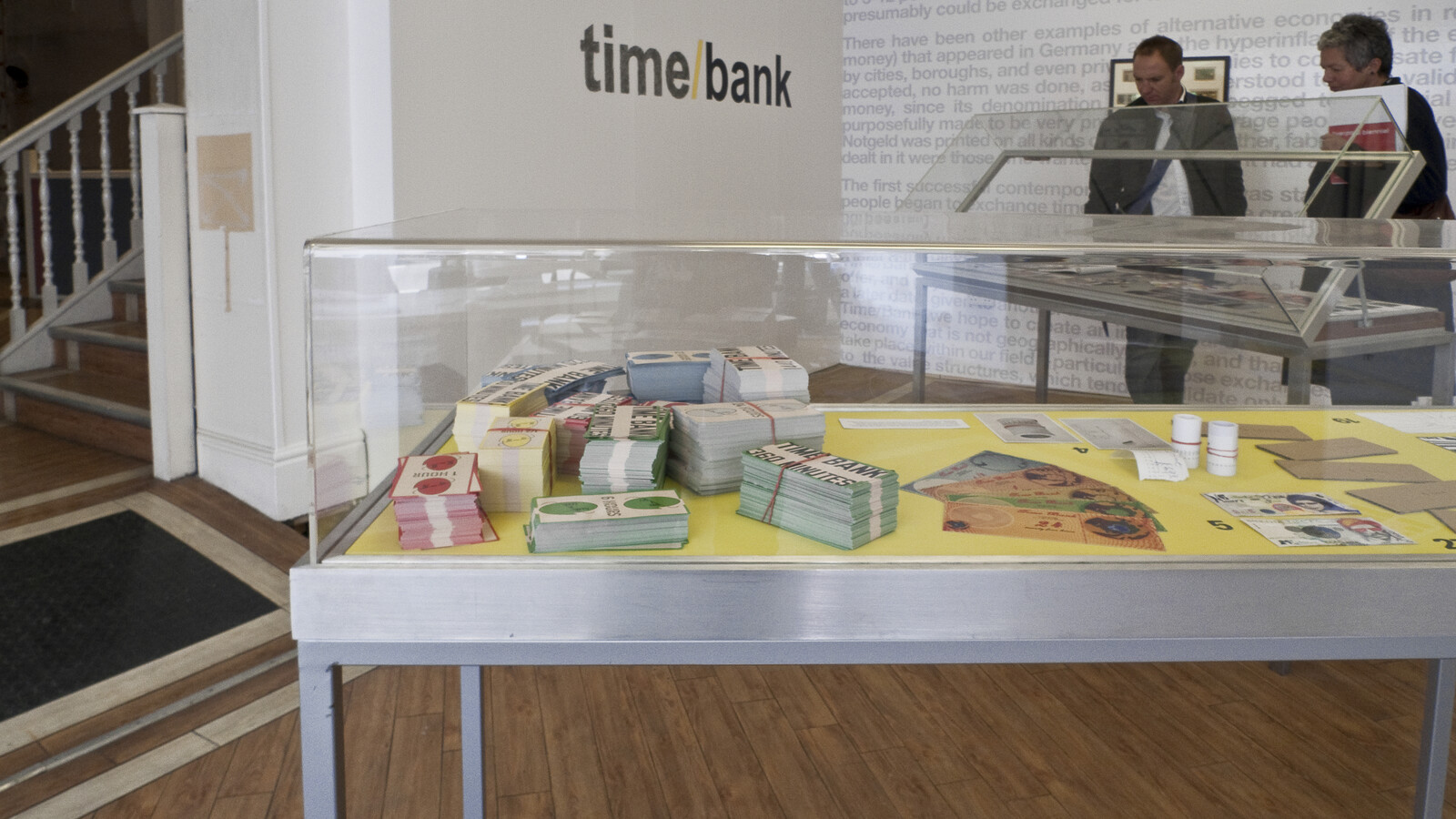
Time/Bank at 5th Liverpool Biennial, UK, 2010

Time/Bank at 5th Liverpool Biennial, UK, 2010

Michael Smith, currency prototype for Time/Bank

Time/Bank at Portikus, Frankfurt, Germany, 2011

Time/Bank at Portikus, Frankfurt, Germany, 2011

Time/Bank at Portikus, Frankfurt, Germany, 2011

Elizabeth Povinelli lectures at Time/Bank at Portikus, Frankfurt, Germany, 2011

Franco “Bifo” Berardi lectures at Time/Bank at Portikus, Frankfurt, Germany, 2011

Raqs Media Collective lectures at Time/Bank at Portikus, Frankfurt, Germany, 2011

Mladen Stilinović, currency prototype for Time/Bank

Time/Bank at Stroom Den Haag, The Hague, Netherlands, 2011

Time/Bank at NAiM / Bureau Europa, Maastricht, Netherlands, 2011

Time/Bank at NAiM / Bureau Europa, Maastricht, Netherlands, 2011
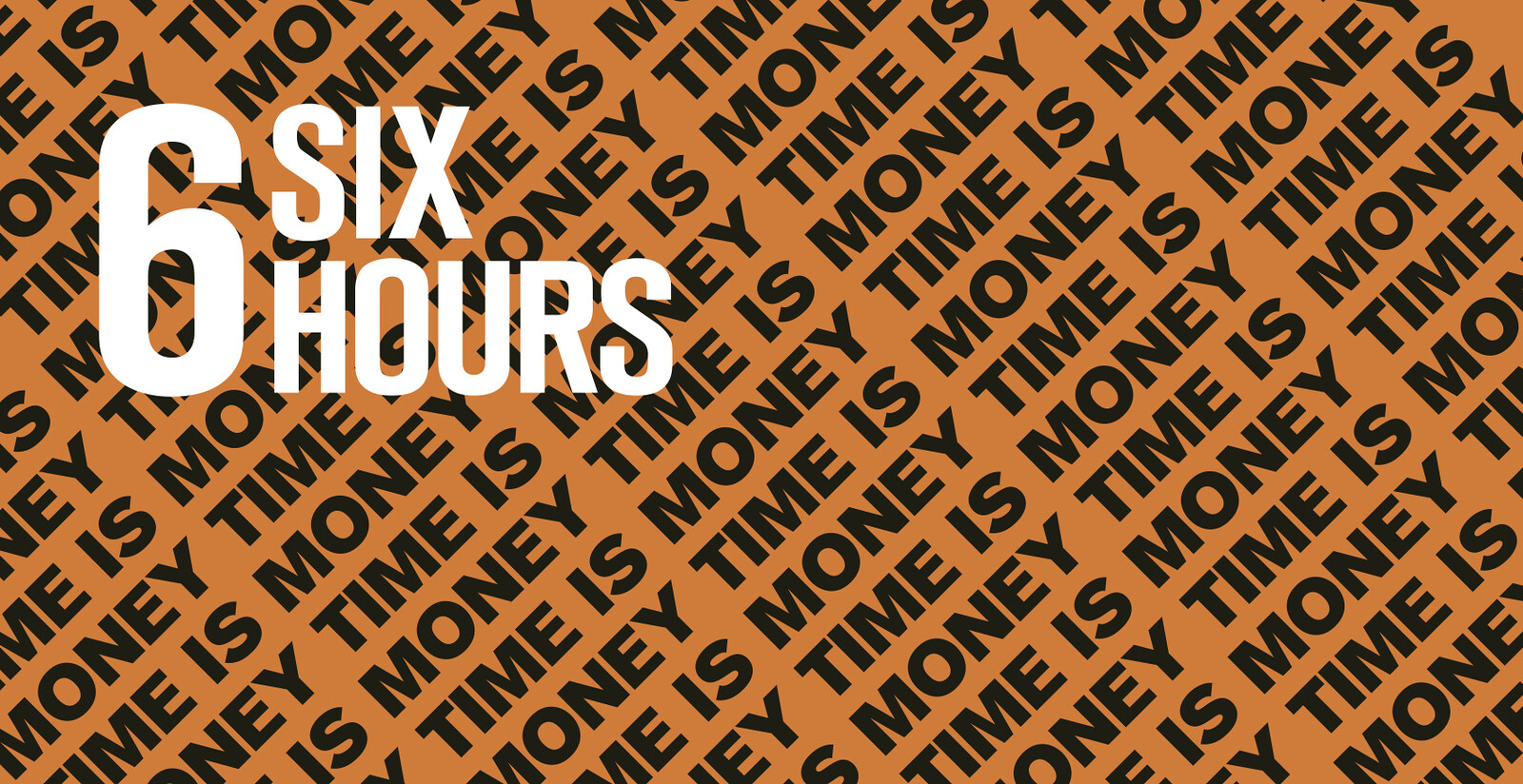
SUPERFLEX, currency prototype for Time/Bank

Time/Food at Abrons Art Center, New York, 2011

Time/Food at Abrons Art Center, New York, 2011

Time/Food at Abrons Art Center, New York, 2011

Time/Bank at Foreman Art Gallery, Sherbrooke, Canada, 2012

W.A.G.E., currency prototype for Time/Bank

Time/Food, Berlin, Germany, 2012

Time/Food, Berlin, Germany, 2012

Time/Bank at documenta 13, Kassel, Germany, 2012
Time/Bank at Frieze Art Fair, London, UK, 2009
Iterations of Time/Bank were developed at the following venues:
Frieze Art Fair, London, UK, 2009
Time/Store, e-flux, New York, NY, 2010
5th Liverpool Biennial, UK, 2010
Portikus, Frankfurt, Germany, 2011
Art Basel, Germany, 2011
Stroom Den Haag, The Hague, Netherlands, 2011
NAiM / Bureau Europa, Maastricht, Netherlands, 2011
UTS Gallery, Sydney, Australia, 2011
Zachęta National Gallery of Art, Warsaw, Poland, 2011
Time/Food, Abrons Art Center, New York, NY, 2011
STUK, Leuven, Belgium, 2012
Foreman Art Gallery, Sherbrooke, Canada, 2012
Time/Food, Berlin, Germany, 2012
Time/Food, Stella Art Foundation, Moscow, Russia, 2012
9th Gwangju Biennale, South Korea, 2012
documenta 13, Kassel, Germany, 2012
MG+MSUM, Ljubljana, Slovenia, 2013
Reviews
“Edge Fund: Time/Bank at e-flux” •
A universal search of e-flux’s Time/Bank project at 3:56 p.m. on Friday, November 12, turns up the following results, listed in descending chronological order: For one hour of time, robgreene in Los Angeles “will provide 1 hour of DJing with either vinyl records, CDs, or both of all your favorite soulful, nostalgic jams!” For 24 hours of time,…
A universal search of e-flux’s Time/Bank project at 3:56 p.m. on Friday, November 12, turns up the following results, listed in descending chronological order:
For one hour of time, robgreene in Los Angeles “will provide 1 hour of DJing with either vinyl records, CDs, or both of all your favorite soulful, nostalgic jams!”
For 24 hours of time, Claudia in Germany asks readers to “send me your artwork, whether finished or in progress, and I will ask random passers-by and/or my grandma how they think you should proceed.”
And for two hours of time, mjg in New York offers to “draw you a picture and mail it to you (or exchange in person if you live in NYC). All I ask in turn is that you get a frame for it and hang it proudly on your wall.”
The currency is time, and the product is cultural work, or auxiliary services surrounding it. In exchange for translating a press release, babysitting a four-year-old or letting somebody crash on their couch—the definition of ‘work’ is subject to interpretation—participants in e-flux’s Time/Bank are awarded “Hour Notes” redeemable for goods on sale at the organization’s Essex Street storefront. (And not just there: a satellite location recently opened in Liverpool, and plans are afoot to launch more). To get involved, time bankers post ads detailing their skills or requesting somebody else’s, positioning themselves in a barter economy that’s occupationally delimited but functionally global.
e-flux dates the origins of time-banking back to British social reformer Robert Owen and American Josiah Warren, an anarchist who brought the system stateside in 1827 with the Cincinnati Time Store. Since then, time-banks have materialized in college towns and economically depressed communities across the country, realigning the relationship between functional value and work in an era of neoliberalism and abstract capital. The most high-profile American system currently operating is the Ithaca Hours, which Paul Glover established in 1991 and christened after its post-industrial hometown. London and Glasgow are also home to notable inner-city time banks, as is the student haven of Madison, Wisconsin, whose branch has over a thousand members. With its 21st century spin on utopian socialism and reliance on grassroots organization, it was only a matter of time before the system was adopted by artists.
While time banking itself falls within an older mold, e-flux’s iteration has a slightly different audience. By focusing exclusively on culture workers, Time/Bank highlights the precarity that unites the creative class with low-wage laborers in the brave new globalized economy. As Andrew Ross observes in Nice Work if You Can Get It, “flexploitataion” and the decline of Fordism have rendered white-collar workers structurally vulnerable, a position that’s mirrored in the migrant workforce. “Once they are in the game,” Ross writes of creative workers, “some of the players thrive, but most subsist, neither as employers nor traditional employees, in a limbo of uncertainty, juggling their options, massaging their contracts, managing their overcommitted time, and developing coping strategies for handling the uncertainty of never knowing where their next project, or source of income, is coming from.” Broke culture workers, in short, are the ideal participants in an economic system that feeds on precarity. Not a new conceit, but one that feels especially significant when surveying the cradle-to-art school wares at the Essex Street store. Time/Bank may enable creative workers to live comfortably as leftists, but it also implies that this is perhaps a less voluntary association than in the past.
A quick scan of the shelves offers dissertations’ worth of material for future cultural anthropologists. In addition to toothbrushes and a variety of dried foods, necessary goods include the following: texts on Hegel and anarcho-syndicalism (30 minutes); condoms (20 minutes); paintbrushes (15 minutes); yoga mat (one hour); guitar (14 hours); Casio watches (2 hours); hemp soap (one hour); Chia Lincoln (one hour); stovetop coffee maker (2 hours); and a blue Peugeot bike—originally fifteen hours, reduced to ten due to necessary repair work. These are the must-haves of a certain subset of the cultural stratosphere, revealing that the project’s real divide is social, not economic.
With this in mind, a prescient question that Time/Bank raises is what counts as work in the creative economy, and subsequently, what qualifies as luxury. An easy way of approaching this is through the division between material and immaterial labor: construction or dog walking read easily as physical work, but what about conceptualizing web projects or curating art shows? In the context of the project, it’s all the same, with quality and value determined by users and unmoored from physical output. Assuming the time costs are the same, fixing a guitar or building a shelf is worth exactly as much as German-English translation or theorizing about art. Ultimately, the question isn’t one of labor, but of value.
In 2007, e-flux planted the seeds for Time/Bank with PAWNSHOP, a project that explored the “poetics of circulation and distribution” by inviting 60 artists to contribute works that would be reclaimed or eventually pawned to the public. “A pawnshop,” the press release explains, “is a stage where merchandise and money dance in a choreography that could have them circle back and cancel each other out, but in fact rarely does.” Rather than floating back and forth over the hazy border between exchange value and use value, items at pawn shops typically sit unused on shelves, slowly going to rot while their monetary avatars are off having a good time. By sticking 60 indisputably valuable artworks in a pawnshop, e-flux forced a clash between contradictory models of value, momentarily transforming a holding cell for unwanted or useless but valuable goods into a kind of gallery space. With the distance between goods and capital ever increasing—or at least, goods and our ability to value them—Time/Bank picks up where Pawnshop leaves off, creating a nearly closed system that’s pegged entirely to use value.
As anthropologist David Graeber points out in his incisive article about art and immaterial labor—a concept he thrashes before leaving for dead—the value of art comes from its recognition by moneyed tastemakers. Artists produce things, Graeber writes, physical items that “financiers can baptize, consecrate, through money and thus turn into art.” Bankers don’t produce tangible items, but it’s their verdict that determines whether an artist shopping in the Time/Bank store is doing so out of luxury or necessity. But Graeber insists that this isn’t cause for anti-capitalist despair: money migrating from bankers to artists enters alternative spaces much the way that government welfare checks do. “It is never clear,” he writes of art sales, “who exactly is scamming whom.” This opaque system of valuation is the referent in Time/Bank, and it’s one that e-flux cleverly undermines by positing a workable alternative. Without necessarily suggesting a fundamental realignment, the project’s central insight is that people will work for what they care about, so long as they’re allowed to determine what matters to them.
“Stirring the Pot | Time/Food at Abrons Art Center” •
Over the past three years, the New York-based, itinerant art organization e-flux has been cultivating a large-scale micro-economy through a project called Time/Bank. Physical branches at museums in Den Haag and Frankfurt circulated an alternative currency whose notes, designed by the artist Lawrence Weiner, are printed in denominations of hours. During…
Over the past three years, the New York-based, itinerant art organization e-flux has been cultivating a large-scale micro-economy through a project called Time/Bank. Physical branches at museums in Den Haag and Frankfurt circulated an alternative currency whose notes, designed by the artist Lawrence Weiner, are printed in denominations of hours. During these exhibitions, anyone could spend time helping others to earn bills, which are redeemable for daily items, groceries, art books and other staples. Julieta Aranda and Anton Vidokle, the artists who founded Time/Bank, call it “a platform that enables people to get things done without using money” — indeed, to this day the bank is still functioning, globally, with more than a thousand users who deposit time into the Time/Bank Web site and withdraw it in the form of skills performed by others.
As harvest season crests, Creative Time has commissioned e-flux to create a permutation of Time/Bank that will open on Sept. 24 at the Abrons Art Center in Manhattan: Time/Food, a temporary lunchtime restaurant serving dishes contributed by a long list of very accomplished visual artists, who also like to cook. Diners need only pledge 30 minutes of their time to sit down to a meal. Some of the recipes, like Paul Chan’s fennel and orange salad, sound like simple, healthy, potluck fare; others, like the New Delhi-based Raqs Media Collective’s spicy shrimp dish “Pirates of the Bay of Bengal,” will appeal to a more daring palate. Don’t miss “Martha’s Mediterranean Spinach,” from the famously methodical kitchen of Martha Rosler. On Sunday, Sept. 25, Rirkrit Tiravanija will serve as Time/Food’s first, and particularly well-seasoned, guest chef.
“ARTISTS COOK LUNCH FOR "TIME/FOOD"”
Artists! Trade a half-hour of your time for an otherwise free lunch at the temporary “Time/Food” restaurant opening in the Abrons Arts Center on the Lower East Side, Sept. 24-Oct. 16, 2011. The menu changes daily according to the rotating roster of chefs, who all happen to be artists “who like to cook.” A few of them are Martha Rosler…
Artists! Trade a half-hour of your time for an otherwise free lunch at the temporary “Time/Food” restaurant opening in the Abrons Arts Center on the Lower East Side, Sept. 24-Oct. 16, 2011. The menu changes daily according to the rotating roster of chefs, who all happen to be artists “who like to cook.” A few of them are Martha Rosler, Paul Chan, Liam Gillick, Carlos Motta, AA Bronson, Mariana Silva, Ingrid Erstad and, on Sept. 25, Rirkrit Tiravanija.
Tiravanija’s kitchen accomplishments are well known, and art lovers with long memories might remember Rosler’s breakout art piece from the 1970s, when she worked at a McDonald’s and supposedly spiked the burgers with marijuana. She reported on her transgression via postcard mail art.
Sponsored by Creative Time, the restaurant is inspired by Mexico’s informal comida corrida-style meals, which typically consist of several courses at a fixed price. Diners receive “hour notes” as currency, which they can take back to the Time/Bank — Julieta Aranda and Anton Vidokle’s larger platform for encouraging its nearly 2,000 participants to barter their time and skills, rather than exchanging money, to obtain goods and services. The website lists classified ads from users seeking anything from interior-design advice to bike repair.
Time/Food is part of the free “Living as Form” exhibition of socially aware art works and commissions taking place around the city. These include exercise classes with Shanghai-based collective Madeln Company, which is leading Physique of Consciousness, a routine of movements inspired by religious ceremonioes, at Sara D. Roosevelt Park; consultations with a “barter advisor,” for one-on-one tips on how to trade skills and objects; or many talks and walking tours on the agenda.
“Project: Time/Bank”
On May 6, 2011, Portikus will become a bank. Initiated by artists Julieta Aranda and Anton Vidokle in 2009, Time/Bank is a platform that enables people to trade goods and services without using money. With a growing pool of more than a thousand participants around the world, Time/Bank allows groups and individuals to collectively exchange their time and…
On May 6, 2011, Portikus will become a bank. Initiated by artists Julieta Aranda and Anton Vidokle in 2009, Time/Bank is a platform that enables people to trade goods and services without using money. With a growing pool of more than a thousand participants around the world, Time/Bank allows groups and individuals to collectively exchange their time and skills through the use of credits earned through the bank, as an intermediary and guarantor. Time/Bank aims to create an immaterial currency and a parallel micro-economy for the cultural community, one that will create a sense of worth for many of the exchanges that already take place within the art field.
At Portikus, the Time/Bank will be comprised of four main components: an exhibition of artist-designed prototypes for a time-based currency; a currency mint that will print and circulate four hundred Hour Notes—one for each hour of the exhibition; an archive of notgeld notes—the legendary German alternative currency popular during the hyperinflation of the 1920s; a branch of Time/Store offering a range of commodities, groceries, and articles of daily use, as well as a selection of artist’s editions and books produced by Portikus.
Time/Bank at Portikus will host a series of public seminars and talks by the theorist and activist Franco Berardi (Bifo); Paul Glover, founder of Ithaca Hours local currency system; anthropologist Elizabeth Povinelli, professor at Columbia University; and artists Raqs Media Collective.
The Frankfurt branch of Time/Bank will include a network of local art institutions and organizations, such as the MMK Museum für Moderne Kunst, Schirn Kunsthalle Frankfurt and the Jewish Museum, amongst others, where the currency of the Time/Bank—Hour Notes, designed by the American artist Lawrence Weiner—can be used for admission, and to make purchases in cafeterias and books stores.
In conjunction with the exhibition, Portikus will publish a book dealing with qualities of time, gift economies, alternative currencies, and other related topics. The book will include commissioned essays and illustrations, as well as contributions by members of Time/Bank.
TIme/Bank Frankfurt Lecture:
Franco Berardi (Bifo)
Tuesday, 10. May 2011, 19:00, Portikus
The main cultural transformation of modern capitalism has been the creation of refrains of temporal perception that pervade and discipline society: the refrain of factory work, the refrain of the salary, the refrain of production line. The digital transition has brought along with it new refrains: electronic fragmentation, information overload, acceleration of the semiotic exchange. Fractalization of time, competition. The essential feature of refrain is the rhythm. Rhythm is the relation of a subjective flow of signs (musical, poetic, gestual signs) with the environment: cosmic environment, earthly environment, social environment. Rhythm is singular and collective. It is singularizing the sound of the world in a special modeling of the environmental sound. But it is able to trigger a process of agglutination, of sensitive and sensible communality. Sometime people start to sing the same song, and to dance the same dance. It can be dangerous, and on this kind of homogeneous subjectivation is based fascism, and modern totalitarianism in general. But it can happen in ironic and nomadic ways. People start to create a new song, and they do it together. That’s a movement.
Franco Berardi, aka “Bifo,” founder of the famous “Radio Alice” in Bologna and an important figure of the Italian Autonomia Movement, is a writer, media theorist, and media activist. He currently teaches Social History of the Media at the Accademia di Brera, Milan.
“Give & Take: On e-flux” •
The story is well known: e-flux, the artist-run announcement service, counts today more than 50,000 subscribers. Its five-letter name has become an everyday noun in the vocabulary of the creative class. Since its launch in 1999, clients have loved the homogeneity and efficiency, and critics have seen a postcritical paradigm shift. Given the…
The story is well known: e-flux, the artist-run announcement service, counts today more than 50,000 subscribers. Its five-letter name has become an everyday noun in the vocabulary of the creative class. Since its launch in 1999, clients have loved the homogeneity and efficiency, and critics have seen a postcritical paradigm shift.
Given the widespread familiarity with the service and the dead-end nature of the but-is-it-art debate, I’d like to scrutinize instead the most recent e-flux enterprise: time/bank, an online bank that runs parallel to the announcement service and issues time-based currency.
Opening an account with time/bank is similar to setting up an e-flux account and simpler than joining Facebook. Your profile is listed in an online directory titled “members/skills” (sorted on a first-name basis). Unlike your regular bank, entry into this connected world is free. Active account holders place ads, offering services valued in time units (say, dog-walking for two hours) or post their needs (a salsa course for four hours).
Time/bank—taking cues from Craigslist and social networks—thrives on peer-to-peer transactions. The dog-walker simply exchanges time with the salsa teacher, their respective online accounts reflecting the balance of this exchange, without the aid of a banker or some other necessary evil.
And here lies the genius of time/bank. In contrast to similar time-based currencies that work mainly as alternatives to an existing market (Ithaca hours or Josiah Warren’s nineteenth-century time store in Cincinnati), transactions at this bank promise the establishment of personal connections that may provide continued benefit, beyond the immediate exchange of goods and services. Culling (mostly) from the pool of e-flux subscribers, time/bank’s clientele consists predominantly of members of the precariat, in this case creative workers whose work is largely remunerated in symbolic terms. For them, walking a curator’s French bulldogs might mean getting somewhere without slaving away as anonymous intern. If you get the curator to cook a savory pot-au-feu, you create an opportunity to socialize beyond the hasty conversation by an institutional photocopier. You will, moreover, stick to a code of honor and not overinflate the value of your time. Bad press, after all, is the worst-case scenario in a market built on interpersonal connections.
A point to be criticized? Not really. According to its home page, time/bank acknowledges exchanges that usually go unnoticed—promsing a sense of self-worth to the exploited cultural worker. This kind of validation, however, instead of boosting one’s self-esteem is more symbolic, and ensures the growth of this market: time/bank understands that a network can expand only if it awards some sense of personal recognition. The least convincing aspect of this initiative relates to its idealistic language. The claims to balance out an unstable market or provide for happiness (as seen on a website affiliated with time/bank) come off as exaggerations, obscuringthe fact that this eudaimonic ideal is premised on the exploitative art-world machine that feeds the belief in the necessity of symbolic exchange.
Such idealism (and somewhat overblown self-historicizing) is best when kept in check. Anarchist or socialist precursors are not about to contradict the financial dependency on the e-flux announcement service and its two smaller sisters, Art-Agenda and Art&Education. Some may find fault here and victoriously declare, “See! Hypocrites cooperating with the dark side of the force!” I would simply suggest that they have found a way to, if not intervene in, then make a perfectly clear comment on, the nonmonetary marketplace that exists parallel to the art market and sustains it. One can’t exist without the other.
Shortly after the online launch of time/bank, time/store opened its doors just below the e-flux storefront on Essex Street, featuring a haphazard collection—a roomba irobot, fake golden Casios, a can of lentils. One might explain this material component as proof of the real-life potential of this parallel market (one still needs that roll of toilet paper and cannot simply live off copy editing or vegan baking). I saw the shop in the lineage of other artist stores (Oldenburg’s, even e-flux’s own pawnshop)—hence the emphasis on random selection, the artist-designed tokens, the not-always-to-be-trusted opening hours, the talkative shopkeeper.
The shop unexpectedly mirrored a shift in tenor in the New York art field. For comparison’s sake, allow me to cross Delancey Street and go to another basement venue: the Artist Institute. Its inaugural, semester-long program (fall/winter 2010–11) was anchored on Robert Filliou. His and George Brecht’s Smiling Cedilla, a short- lived nonboutique in Villefranche sur Mer—maybe more a pretext to hang out than a gallery—stands undoubtedly as a model for the Institute. The Institute’s insistence on slowness and small scale speaks to the playful resistance to production expressed by Filliou & Co. What is to be appreciated in the AI (counter to what the name suggests) is its levity: its banner doesn’t waft terms such as discourse, critique, or research. The organizers simply invite you to “spend time” with them and the works on display. In comparison to artist-designed conversation platforms, one is not hailed as a provider of a service or as possible coproducer of discourse. What matters, it seems, is experience, rather than service.
E-flux fans are generally keen to underscore the “discursivity” of the entire apparatus (in fact, the term appears in an effort to legitimize the whole undertaking as an art project: the “object” is not a painting but instead immaterial “discourse”). Time/bank and time/store, while moored in an efficient international productive sphere, initially seemed to escape this yoke. Through browsing and surprise, the store and bank echoed some of that AI postdiscursive wind. There, the participant, though a member of a network of symbolic value, was not asked to maintain that circle of letters/thought/discourse, as in a Habermasian sphere of letters inside a gallery. Anchored in an efficient contemporary sphere of production, they hint at experience sans the pressure to produce a critique. By contrast, the store’s more current incarnations, at Portikus, Stroom Den Haag and even Art Basel, signal the intent to go global. They come with panel discussions and a publication, suggesting that the upstairs organizers do insist on summoning their account holders as willing listeners in, and occasional providers of, critical conversation.




